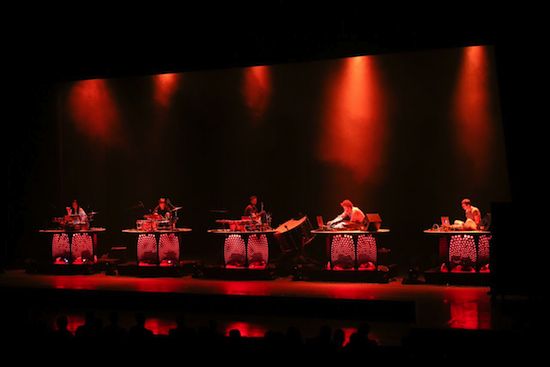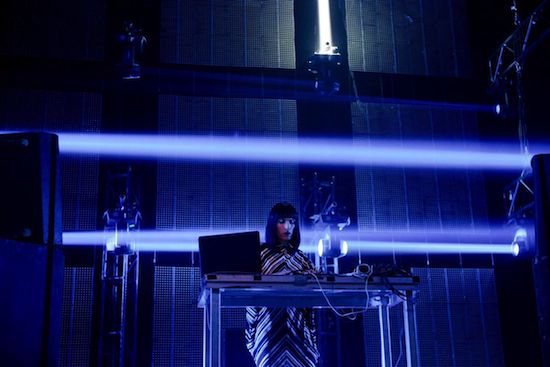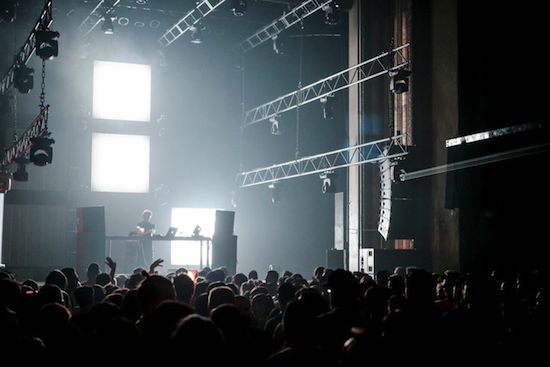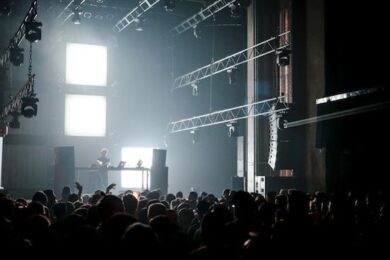Photo by Brian Park
The grass is greener
Now in its sixteenth year, MUTEK digital arts and media festival possesses a nearly perfected formula, all the while leaving just enough room for growth. Attendees have learned to buy into the range of programming, exhibited platforms, workshops and eagerly jump right into the creative culture MUTEK has spawned.
It’s my fifth consecutive year of attendance, and it’s safe to say that the festival has won me over by consistently meeting my rising expectations. This sense of trust is as rarified as it is welcomed, mainly because I am driving in from a country where electronic music is controversial at best, and inconsequential at worst. I look forward to the annual trip up from New York precisely for this stark contrast. Sure, the city’s house/techno scene is in a state of flux, arguably for the better. Yet, there is still no single event that fosters the community, local support, by fulfilling MUTEK’s adventurous range and persistent scope. Perhaps one of the festival’s greatest assets is intrinsic: Montreal. A city historically entrenched in the arts, it also happens to be Canada’s most diverse, with roots spilling out in many different directions. Naturally, this has bred a social make-up steeped in tolerance and fertile cultural soil. With conditions like these, electronic music tends to bud and bloom.
A known fact is that MUTEK functions as a non-profit organisation. An obscure fact, is that the majority of the festival’s funding is derived directly from the government’s arts budget, municipally, provincially, and to a lesser extent federally. A fact that any US resident is sure to find mind boggling. That being said, the talk of the town was that MUTEK faced budget cuts this year, in form of a sweeping 20% tax cut being withheld from all cultural organisations such as MUTEK.
Push the envelope
This time around, I pull into town on Thursday evening, not by choice but rather by circumstance, which in the grand scheme of things is late for this festival considering that an entire day and night of programming had already come and passed. I prepared myself to hear second hand recaps of what James Holden’s live set may have been like as I headed to the nerve center of the festival – The MAC-Musse d’Art Contemporain, one of the main venues hosting a variety of evening programming. I head down to the basement, the smaller of the two rooms, in time to hear Warp label artist and synth-connoisseur Richard Devine premier his ‘Disturbances’ series. His custom built live patch assures that no one performance can replicate another, stipulating spontaneous arrangements. The sounds Devine produces run the gamut from ambient overlays to abrasive rhythmic patterns, precipitating varied reactions, drawing in some spectators while others run for cover.
Admittedly, MUTEK’s musical programming this year seems to be in it’s most adventurous and niche-orientated state, urging the laymen to broaden their scope and let something new in. Devine’s performance epitomises the sentiment, easily reenergising even the greatest cynic. I end my first night back at my Airbnb apartment in the heart of the plateau district, contemplating the cultural currency of pushing the envelope.

Photo by Brian Park
Montreal, little, big city
On Friday I branch away from the troop I’m staying with, deciding to wander around downtown and see what’s changed in the city-centre since last time I was in town. In doing so, I encounter several pieces of urban art although, one installation in particular seems to stick with me. It’s called 21 Balancoires, or, 21 Swings. A seemingly simple idea, yet, it zeroes in on some of the most meaningful and public attention.
Originally created by two local artists: Mouna Andraos & Melissa Mongiat, the swings have been up for quite sometime now, and locals adore them. Each swing, when in motion, acts as a instrument leading to randomised melodies developing. Sure enough, festival-goers make good use of this installation over the weekend. Art like this is what I’ve come to expect from big cities. Still, the confluence of ideas and culture in this city is bigger than the estimated 1.68 million people who live on this Quebecua island.
After taking in some city sights, I re-connect to the festival and head over to the MAC to meet old friends and mingle. I also first learn of this year’s venue changes for the weekend afternoon program. The customary daytime event in conjunction with the Montreal staple open air event Piknic Electronic is no more. In its place will be three consecutive days of free daytime programming hosted at a stage within a small green space directly in the urban center called the Parterre Du Quartier des Spectacles. This is an obvious reaction to last year’s Piknic, which ballooned uncomfortably to record capacity. I wonder if the festival’s apparent attempt to contract is a matter of logistical necessity, or perhaps a voluntary decision to withdraw from the mad hype of popularity and profit.
While there, I dip into Salle Principal, the main room of the MAC, just in time to catch Karen Gwyer perform. Already familiar with her acerbic techno productions, I’m intrigued as to how they translate into live performance. As I arrive, her formulas are already crunching, filled with wispy drum patterns and hypertonic melodies. It’s striking how much more acutely one can focus on mid and hi-range sounds with music this weightless, floating by anchored only by gentle kicks. Gwyer turns herself over during the performance, moving in waves onstage, in and out of a trance-like state. There’s a very intimate component to her performance and it serves as an optimal lead to the main course of the night.
Expect the unexpected
Behold, the first of two night nocturnes in the behemoth Metropolis traditionally hosting Friday and Saturday night programming. This institutionalised theatre is unique in that it can accommodate up to 2300 people without sacrificing sound quality, due to its classic 1884 design and refined acoustics. It also boasts the strongest visual components of the festival, with elaborate projection and lighting rigs.
I arrive just as Ostgut Ton’s Steffi is getting started with her live set, her rounded 4/4 patterns finding a natural home in the cavernous room. It’s a straight forward rhythmic display, essentially begging for movement in return. On the heels of Steffi’s set comes the undisputed, most elusive figure of the festival: Rrose. Dressed as his alter-ego, the name of which references one of the pseudonyms of French conceptual artist Marcel Duchamp, he blows the room away. The set is both complex and ethereal, and moves at a harnessed pace, peaking with swirls of sound that give way to gorges of melancholic techno. Lucy steps up and finishes off the night with a dexterous helping of smart, clean big room techno that could easily transport a seasoned listener to any given morning at Berghain.

Photo by Brian Park
Follow your tastes with an open mind
Projected tracks of programming plans at MUTEK are carefully and unpredictably geared by taste. One goes in pursuit of one artist and winds up a fan of another that is cleverly hemmed into the lineup. Saturday starts quite slowly due to a lengthy after-party the night before, and after some much-needed food and coffee I rush over to the Theatre Maisonneuve to catch the second of the A/Visions program, primarily for Field recordings cohort Martin Messier. I arrive only in time to hear the Canadian premiere of Tyondai Braxton’s HIVE. There are five performers lining the stage, each perched on a hexagonal column, transilluminated by neon flutters. Three of the five are on organic percussion, with one manning a huge orchestra style bass drum. For a group sitting so far apart onstage, these artists are exceptionally in sync with each other. With Tyondai himself and another member manning a modular synthesiser, each creating loops and sequences in Ableton Live. There is definitely a free form element to the sounds being generated by the artists on the synths, even though the percussion element definitely follows a set structure. The performance feels like some alien form of jazz. The performance ends and the audience spills out into the theater’s lobby to convene to discuss the abduction until the theater staff usher us all out for cleanup.
Saturday night’s tradition brings me to the upper decks at Metropolis. By then, AtomTM and Tobias are already at it, building a set of hardening, textural techno. The energy mounts, and just as quickly as the pair set the evening’s context, it’s time for Daniel Bell, with John Tejada in tow with live drums. They reproduce and seamlessly weave through DBX classics, offering a lushly nostalgic contrast to the prior German dystopian futurism. The pair finish a treasured retrospective, and in the brief intermission the multitudes prepare for the Métropolis finale. Bespoken as one of the sole DJ sets of the festival, the Japanese Perlon stalwart Fumiya Tanaka enters the fray. An ideal fit for the night’s proceeding, he cuts all of the tension of history and hardware in one fell discus swoop. Mr G’s ‘Lot To Say’ and Soundstream’s ‘Sweep Magic’ lead to the crowd rushing the floor to bounce and contort. Tanaka delivers a set both playful and profound. As we sway and grin, he ends the night with what may be the most fitting closing track I’ve ever heard: Trackheadz’ ‘Our Music’. Sustained strobes during the record’s breakdown allow for enough light to reveal a sea of smiles abound all over the dance floor.
Save the best for last
Generally, the way a festival’s closing day/night program goes, the tendency is to save your best for last. Music that is strong and binding. I choose to go down to the Parterre Du Quartier des Spectacles to test out the free outdoor stage: ‘The Experience’. I’m just in time to catch a full DJ set by Hyperdub label boss Kode 9. The set is laden with loud grimy grooves – tracks like ‘Love You’ by DJ Rashad and DJ Lucky pull fans of UK bass music in closer to dance on beat as the majority look on and sway.
The last night brings with it the most cohesive on paper lineup of them all. As opposed to nights past, when I get to the main room at the MAC, I notice a sizable lift and punch of the volume. Germans Session Victim make good use of it as they quite easily deliver one of the highlights of the week. Their hybridised take on house and techno, driven by live bass guitar and analog gear with a large helping of personality blows the crowd away. Cobblestone Jazz take the coveted closing slot. Local hero Mathew Jonson, armed with original members Danuel Tate and Tyger Dhula arrive onstage to adulating applause that one would expect at the end of a performance. The trio perform their patented depth of sound techno, with distinct grooves, rolling bass lines and live piano lines. Long arrangements lent the crowd enough time to stick with the beat patterns so that they could come together long enough to dance in practical synchronicity. This set serves as an ideal way to close the night and chapter of MUTEK history.
The staying power of MUTEK seems to lie in between the lines. People repeatedly come to the festival because of the relationships they’ve forged, with the city, its locals and artists alike. MUTEK has the uncanny ability to build and foster relationships, utilising electronic music as the glue. This inevitably leads to the shortening the gap that exists between the artists and clued in crowds. All these qualities in one place are hard to find and hold onto in today’s electronic music landscape.
<div class="fb-comments" data-href="http://thequietus.com/articles/18111-things-learned-at-mutek-review” data-width="550">



